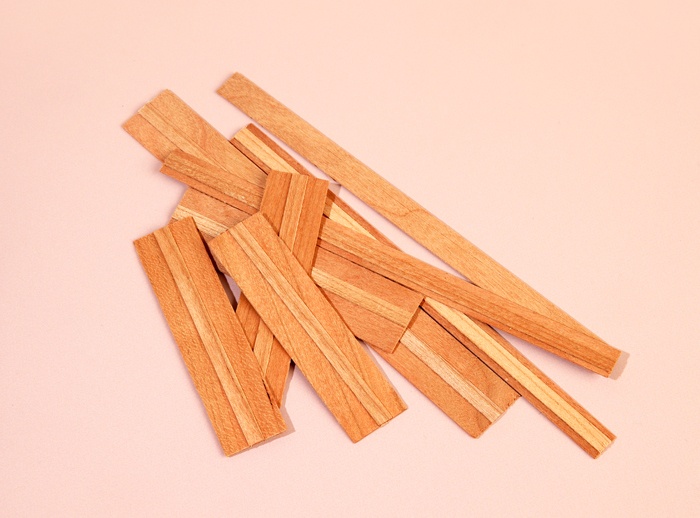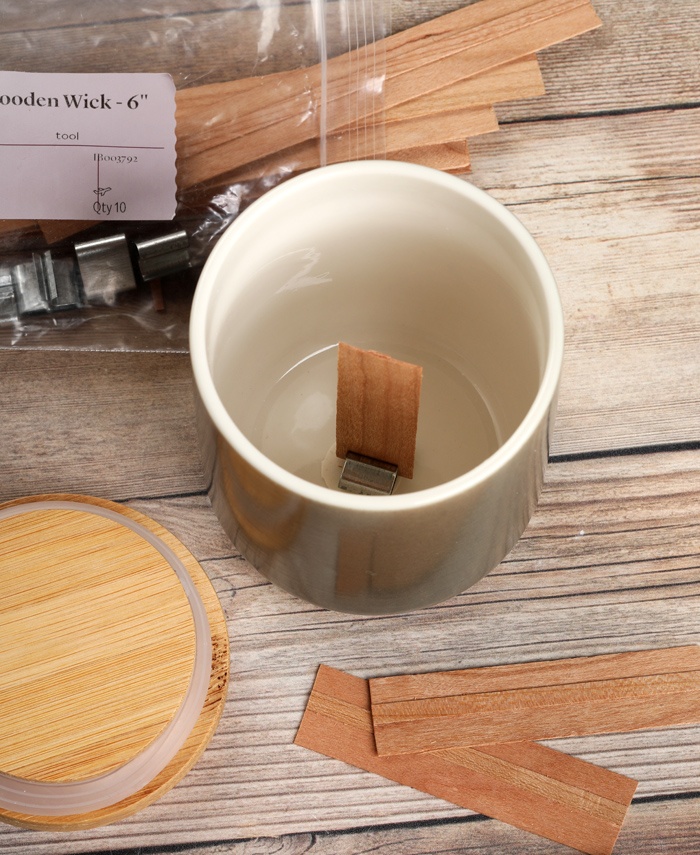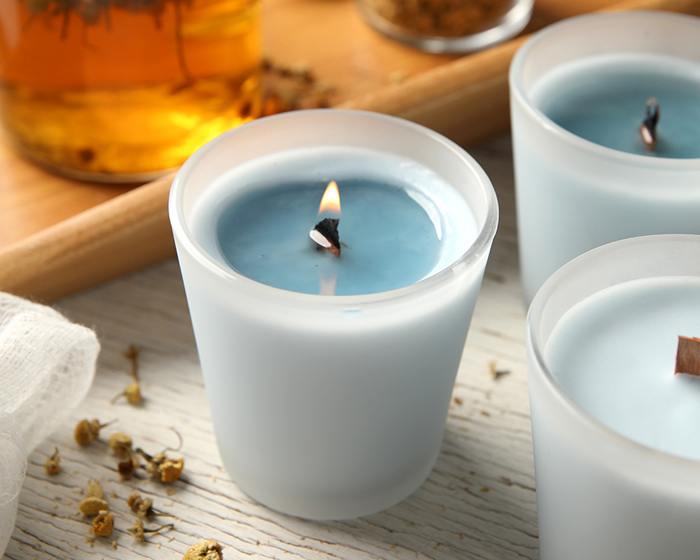
Whether you’re a candle making beginner or a veteran wanting to add a little something extra to your DIY candles, wood wicks might be just the thing for you! If you’ve never used wood wicks before, they can add a special charm to your handmade candles, but there are some things you’ll want to know before you commit.
What are wood wicks?
Wooden wicks are just what they sound like; a candle wick made of wood. These wicks are typically thin, flat strips of wood. It may not look like it, but wooden wicks deliver melted candle wax to the candle flame just like traditional cotton wicks do; the wax travels up the wicks through capillary action.

How are wooden wicks different from cotton wicks?
Even though wooden wicks work in the same way as cotton wicks, there are some key differences.
Easy to use
Because the wooden wick stands up easily in the container while you pour your wax and while the wax hardens, these wicks can be easier to use than your standard cotton wick. There are also fewer types of wood wick. This means that while you have more flexibility with cotton wicks, choosing a wooden wick for your candle is probably simpler.
Rustic look
A big part of the appeal of these wicks is their appearance. A simple piece of wood emerging from the top of your candle has both a modern and rustic feel, and lots of people enjoy the novelty of a wooden wick, since they’re a relatively recent addition to the handmade candle space.
Flatter flame
Cotton wicks tend to produce a taller, round flame, while wooden wicks produce a flatter, lower flame. This means that while candles with cotton wicks may provide more light, wooden wicks may provide a little more ambience.A lower flame keeps the heat closer to the melt pool of your candle, too. This means more melted wax in your pool, which may increase the scent throw of your candle!
Crackling sound
Wooden wicks produce a soft crackling sound that many find pleasant. This crackling is caused by the same processes that make a campfire crackle; substances in the wood transform into a gas when heated, and that gas expands, causing the material around it to break open with a crackling sound. Different types of wooden wicks can produce different kinds of crackle!
Burn duration
Because of their lower flame, wooden wicks tend to consume wax more slowly than cotton wicks, meaning that your candle will typically last longer. Everyone knows that sad feeling of a favorite candle running out, so one that lasts longer is a big advantage.
Higher maintenance
Cotton wicks are pretty easy to maintain, but wooden wicks are a little fussier. Wooden candle wicks need to be trimmed regularly to make sure that they’re burning well, while most cotton wicks in use today are self-trimming. Wooden wicks can also be more difficult to light, sometimes taking a few tries to get them going. Wooden wick fans will tell you that they’re worth the extra effort, though.
Types of wooden wick
There are a few different types of wooden wicks that you’ll want to consider when planning your wooden wick candle project:
- Flat - Flat wooden wicks are a simple, single ply strip of wood.
- Booster - Booster wooden wicks include a thin strip of wood attached to the main wick. This allows for more wax draw and a hotter flame.
- Spiral or Tube - Spiral or tube style wooden wicks are made of wood shaped into a spiral or tube. These will burn hotter and produce a rounder flame, and are best for bigger diameter candles.
- Crackle - Crackle wooden wicks are those that produce a louder crackling sound when burned.
- Whisper - Whisper wooden wicks still produce that characteristic crackling noise, but it’s softer.
Choosing the right wax for your wooden wick candle
The kind of wax you’re using is always important when you’re planning any DIY candle project, and the same is true for wood wick candles. Though wooden wicks will work with most candle waxes, you may consider the type of wooden wick you’re going to use.
Flat or single ply wood wicks are going to work best for your thinner waxes, like our Coconut Soy Wax. For thicker waxes like beeswax, you’ll want to look into using a booster wick or even a spiral wick. The consistency of the melted wax determines how much of it will flow up the wick, which means that your flame may burn bigger and hotter, and that your candle may be consumed more quickly. On the other hand, using a thin wick with a more viscous wax may mean a lower flame, and can cause performance problems like tunneling.

Trimming wooden wicks
One thing to keep in mind about wood wicks is that they require a little more maintenance than a cotton wick. While many kinds of cotton wicks used today are self-trimming, wood wicks are not.
A wooden wick should be trimmed before each burn. It can also be trimmed after, but be sure to wait until the candle has cooled and the wax has fully solidified before you do to prevent any debris from falling into the melted wax.
You don’t need any special tools to trim wooden wicks. They’re thin enough to trim with a normal wick trimmer, a pair of scissors, or even a nail clipper. Trim your wood wick down to a quarter inch above the surface of the wax.
Many problems with burning wood wick candles can be resolved by trimming the wick!
Now you know the most important things about using wooden wicks in candles. You can view our line of wooden candle wicks here. If you’re looking for a little inspiration, we have several candle making projects (even some with wooden wicks!) for you to browse. With this knowledge, we’re sure that your wood wick candle project will be a success!

